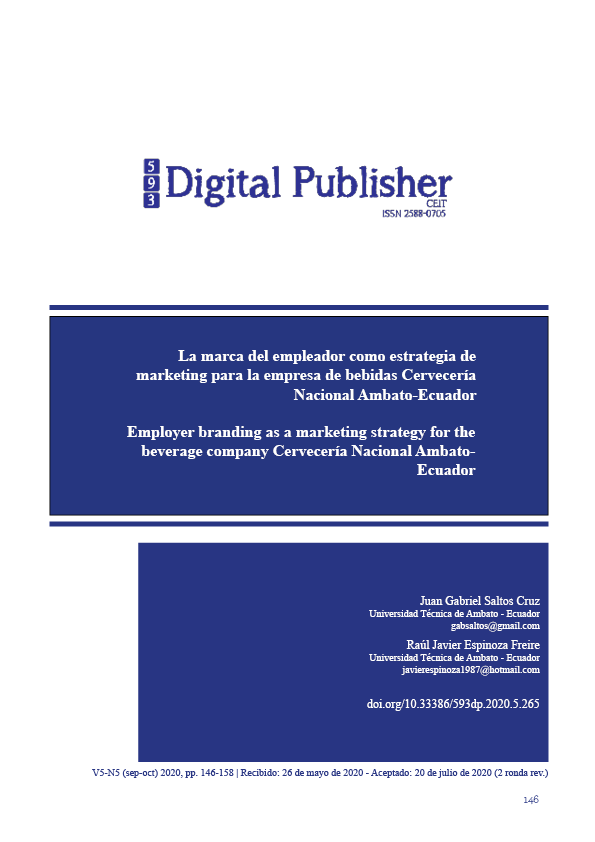La Employer branding as a marketing strategy for the beverage company Cervecería Nacional Ambato-Ecuador
Main Article Content
Abstract
The objective of this research is to propose a marketing strategy on Employer Branding for the beverage company Cervecería Nacional Ambato-Ecuador. The problem identified is the absence of marketing strategies on employer branding, as well as the absence of transmission of employment benefits on social media. Being a descriptive study, the analysis-synthesis method is used from a bibliographic investigation. A Cronbach's Alpha of 0.85 and 0.83 was obtained in the surveys of the companies in the sector and the employees, respectively. In addition, the chi-square was used, verifying that the objective of the EB strategies influences its application in companies. Among the results, the strategy with seven phases was proposed, which will serve as a support for the companies in the sector to promote and publicize the benefits that the employees of the company possess by providing their services and being part of it.
Downloads
Article Details
1. Derechos de autor
Las obras que se publican en 593 Digital Publisher CEIT están sujetas a los siguientes términos:
1.1. 593 Digital Publisher CEIT, conserva los derechos patrimoniales (copyright) de las obras publicadas, favorece y permite la reutilización de las mismas bajo la licencia Licencia Creative Commons 4.0 de Reconocimiento-NoComercial-CompartirIgual 4.0, por lo cual se pueden copiar, usar, difundir, transmitir y exponer públicamente, siempre que:
1.1.a. Se cite la autoría y fuente original de su publicación (revista, editorial, URL).
1.1.b. No se usen para fines comerciales u onerosos.
1.1.c. Se mencione la existencia y especificaciones de esta licencia de uso.
References
Acar, P., & Yıldırım, G. (2019). The effects of employer branding and career anchor on intention to leave: An empirical study. International Journal of Research in Business and Social Science, 8(5), 2147- 4478. doi:10.20525/ijrbs.v8i5.454
Aguila, F., Rubio, D., & Silva, D. (2014). Dimensiones determinantes del employer branding en atracción y retención de jóvenes profesionales chilenos. Título de pregrado, mención Administración. Santiago de Chile, Chile.
Ahmed, P. K., & Rafiq, M. (1995). The role of internal marketing in the implementation of marketing strategies. Journal of Marketing Practice, 1(4), 32.
Astudillo, M., & Barriga, S. (2019). La percepción de la experiencia de compras en el comercio electrónico, desde un enfoque teórico práctico. Ciencia Matria, 5(9), 199-224. doi:10.35381/cm.v5i9.142
Backhaus, K. (2004). An exploration of corporate recruitment descriptions on Monster. com. International Journal of Business Communication, 41, 115-136.
Backhaus, K. (2016). Employer Branding Revisited. Organization Management Journal, 13, 193-201. doi:10.1080/15416518.2016.1245128
Backhaus, K., & Tikoo, S. (2004). Conceptualizing and researching employer branding. Career Development International, 9, 501-517.
Balmer, J., & Gray, E. (2003). Corporate brands: What are they? What of them? European Journal of Marketing, 37, 972-997.
Cervecería Nacional. (2020). Obtenido de https://cervecerianacional.ec/
Cervecería Nacional. (2020). Formulario de aplicación de las vacantes laborales. Obtenido de https://bit.ly/2VBEaa6
Criollo, M., Erazo, J., & Narváez, C. (2019). Estrategias de Marketing y posicionamiento de marca para el sector artesanal textil. Ciencia Matria, 5(1), 245-270. doi:10.35381/cm.v5i1.266
Dabirian, A., Paschen, J., & Kietzmann, J. (2019). Employer Branding: Understanding Employer Attractiveness of IT Companies. IT Professional IEEE, 21, 82-89. doi:10.1109/MITP.2018.2876980
Edwards, M. (2010). An integrative review of employer branding and OB theory. Personnel Review, 39, 5-23.
Gordhan, K. S., & Jawahar, I. M. (2019). The influence of employer rankings, employment experience, and employee characteristics on employer branding as an employer of choice. Career Development International, 24(7), 636-657. doi:10.1108/CDI-11-2018-0290
INEC. (2019). Ecuador en cifras . Obtenido de https://www.ecuadorencifras.gob.ec/mas-de-900-mil-ecuatorianos-consumen-alcohol/
INEC. (2020). Directorio de Empresas 2018. Obtenido de http://redatam.inec.gob.ec/
Lloyd, S. (2002). Branding from the inside out. Business Review Weekly, 24(10), 64-66.
Mandhanya, Y., & Shah, M. (2010). Employer branding - a tool for talent management. Global Management Review, 4(2), 43-48.
Naudé, P., Desai, J., & Murphy, J. (2003). Identifying the determinants of internal marketing orientation. European Journal of Marketing, 37(9), 1205-1220.
OMS. (2018). Centro de prensa. Obtenido de https://www.who.int/es/news-room/fact-sheets/detail/alcohol
Rodríguez, A. (2012). Employer branding: un estudio sobre la construcción de la marca del empleador. Tesis doctoral. Madrid, España.
Sánchez, H. M., & Barriusos, I. M. (2007). Explorando la relación entre la Reputación Corporativa y el Employer Branding. Conocimiento, innovación y emprendedores : camino al futuro, 3144.
Steenkamp, E. M. (2017). Estrategia de las marcas. España: Mc Graw Hill.
Theurer, C., Tumasjan, A., Welpe, I., & Lievens, F. (2018). Employer Branding: A Brand Equity-based Literature Review and Research Agenda. International Journal of Management Reviews, 20, 155-179.



